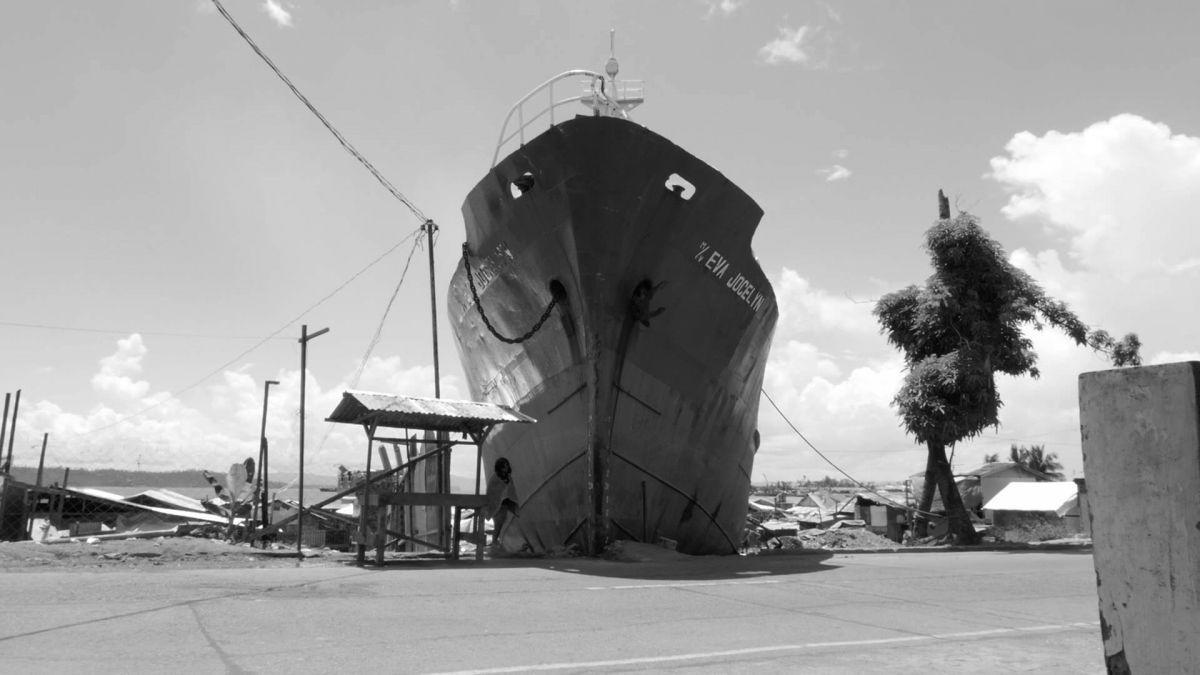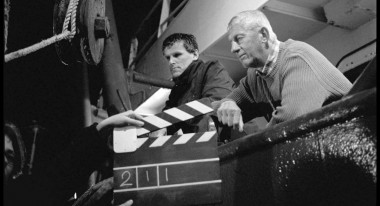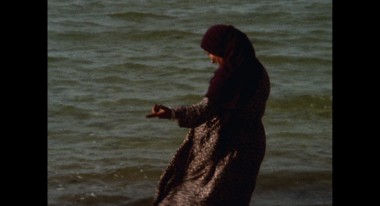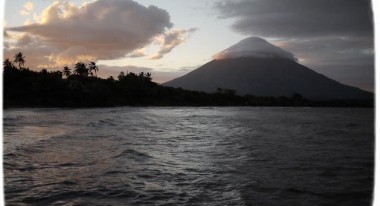 Back to selection
Back to selection
The Raisers’ Edge: MoMA’s Transcendent “Documentary Fortnight”
 Storm Children — Book One
Storm Children — Book One Low and high art come to fruitful blows in the 14th edition of one of New York’s most substantive — and absurdly unsung — cinema exhibitions, the International Festival of Nonfiction Film and Media, aka Documentary Fortnight (February 13-27). Low? For 120 years, film has been on the short end of the cultural totem pole, and host venue Museum of Modern Art has never made any bones about the distinction. In this case, however, the medium is infused with accomplished elements from other art forms ranking among the cognoscenti.
Long before complementary fora like DOC NYC and the Film Society’s Art of the Real capitalized on the new popularity and coolness of the genre, two weekly programs at MoMA celebrated the form: Willard Van Dyke and later Bill Sloane’s What’s Happening (1970-1995) and Sloane and Sally Berger’s New Documentaries (1995-2001). The latter morphed into the annual Fortnight in 2001. “Festivals have a flair that is lacking in a weekly series,” says Berger.
She has been sole program director since 2006, with academics Chi-hui Yang (a Flaherty Seminar maven) and filmmaker Kimi Takesue curating alongside her. The current concept combines the social consciousness of the pretty conventional docs shown in the earlier two series with an avant-garde aesthetic, born of Berger’s engagement back in the ‘80s and ‘90s with videomakers who were creating artworks with a healthy dose of non-fiction material.
What distinguishes the Fortnight from other doc fests and exhibitions? For lack of a better term and enough knowledge of the Fortnight’s prehistory last year, I labelled the films non-fiction plus. Yang gives me a hand:
It is a series which is interested in exploring creative forms/innovations in non-fiction filmmaking across all sectors of the documentary world, in diverse contexts such as public television, the gallery, museum, or cinema. We hope to offer a larger portrait of the moment, and how makers are responding to the constantly shifting conversation about how to represent the real. For example, what might link a social-justice documentary with a hybrid-fiction experiment? We examine the connective tissue.
Whatever ideologies, methodologies, and contexts drive these films, from start to finish they ooze complexity and purity. In Storm Children—Book One, Lav Diaz records what he comes across, determining in the editing room a final, subtly manipulated outcome: his truth. On the opposite end of the spectrum, Lonnie van Brummelen and Siebren de Haan relay their version of veracity in Episode of the Sea through patently artificial constructs inspired by actual situations and conversations.
Three immediately accessible, honorific docs by high-profile directors anchor the challenging eccentricities. Barbara Kopple’s impressive closing nighter Hot Type: 150 Years of The Nation, an finely proportioned brew of news stories and talking heads, puts to shame Martin Scorsese and David Tedeschi’s overly hagiographic New York Review of Books big-birthday doc The 50 Year Argument. Opening the fest is Stanley Nelson’s thorough The Black Panthers: Vanguard of the Revolution, a time-capsule’s worth of clips and interviews detailing the movement’s place in history while simultaneously subjecting it to a balanced Rashomon-like perspective. Dutch director Heddy Honigmann’s “mid event,” Around the World in 50 Concerts, is a limpid tour-along on the occasion of the Royal Concertgebouw Orchestra’s 125th anniversary that will disappoint those hooked on her earlier blending of poignancy and quirkiness in films like Crazy and Forever.
Of the 18 outside-the-box features (the show also has seven shorts), the five absolute must-sees are reviewed below. Beyond the abstract characteristics discussed above, they share a few common denominators: the Straub-Huillet syndrome, i.e., couples sharing the director’s settee or loveseat, depending (I haven’t asked who are merely colleagues); the presence of filmmakers on camera and/or on the soundtrack; the makeshift, to be expected in docs shot with immediacy in economically underdeveloped zones; board games — that’s right — including chess and even moreso dominoes, for which the only explanation I can suggest is that these leisure-time pursuits are available in regions marked by poverty or rupture; and, more than anything, water.
Water, water, everywhere. Whether subject or participant, on- or off-screen, the most successful films showcase the element. (Three of my five top last year did as well, mostly water in the form of snow.) It’s as if sufficient hydration is a prerequisite for inclusion, waterloggedness a ratings booster. Why, I’m not sure, but water is multifunctional and in its various forms seductive. It covers 71% of the earth’s surface: Things don’t get much more universal.
Episode of the Sea (Lonnie van Brummelen and Siebren de Haan, Netherlands)

Amster Amster/damn damn damn. The Dutch government, expecting the fishermen who thrived there to switch to farming, filled in the sea around the island of Urk. (Yes, I know the capital is The Hague.) They lost their island but not their livelihood, taking their craft far out into the North Sea. The Urkers redirected a structuring absence into a structuring presence. Van Brummelen and de Haan have noted their ability to “absorb instability.”
The co-directors set out to prove that they too possess that capacity. To do so requires a redefinition of filmmaker and subject. The latter is slippery: The seamen on the boat we see in the film are not the ones they travelled with for nine months. They are rather fellow Urkers reciting lines gathered from earlier encounters with the workers themselves. To make clear that these are not the real subjects, these amateur actors from Urk stiffly declaim their dialogue, facing forward, their faces and bodies strongly lit and seemingly engraved into the pristine 35mm black-and-white stock. No faux verite here, no transparency: The film is rigorously Brechtian. We are mere observers locked out of the narrative.
Rolling text pointing out the similarities in M.O., equipment, and place in the social order neutralizes the subject-observer distinction further. The filmmakers make the point that their own obsessive labor compiling data stems from the same conservative Calvinist culture that has begotten these stubborn, hard-working people who have overcome the obstacles of isolation and a singular mother tongue to challenge, cleverly, what they consider unfair quotas and restrictions. Both fisherfolk and moviemakers have image problems, per the text, use out-of-date technology, and collaborate to reach closure for their processes.
We know the drill in filmmaking, but in case we don’t get the parallel between two marginalized professions, van Brummelen and de Haan show us each and every step involved in fishing: on the boat, dropping huge nets and hauling them back in, and separating varieties and placing flatfish and other desired catches on ice; back on land, cutting off heads and fileting, then packing (women do the sedentary work). All of this is divvied up into 12 distinct chapters, with headings like “Analogues” and “Contingencies” that stress the overlap.
Anticipating the tight structure is a brilliant prologue in which Urkian women stand absolutely still on terra firma reciting poetry recapping the imposed history of their land- and seascapes. Immediately following are overhead shots of a calm sea. Once the filmmakers are on board, waves begin crashing into the ship. When nets are raised, water pours onto the deck hard and fast. The filmmakers reference their intense seasickness.
At the same time, we see that life for the Urkers is hardly a joyride. We can’t preview their future, but visual and textual hints suggest that their way of life is no longer lucrative. On the positive side, we learn that they are attempting to produce materials that could help update their relationship to technology and the market.
Brule la mer/Burn the Sea (Nathalie Nambor and Maki Berchache, Tunisia/France)

The disappeared coastline that once delineated the island of Urk is a vastly different kettle of fish (‘scuse me) from the geographical and emotional frontier that separates the 25,000 Tunisians who fled their homeland at the time of the Jasmine Revolution from mother-country France. The destination turns out to be more nightmare than dream. The Urkers are Dutch: They negotiate their place in the economic and social sphere as fellow nationals, equals under the law.
Not so the immigrants, called harragas, who illegally burn the sea in boats to get to a haven like Lampedusa before continuing on to life as second-class citizens — frequently unemployed — in charmless surroundings like the banlieus outside of Paris. How the new life contrasts with the colorful textures, rich melodies, and human warmth in the Tunisia of their memories. In an ironic reversal, the latter becomes the dream. In this rich feast of a film, co-directors Nambor and Berchache alternate the volume between hushed and rowdy as successfully as they themselves process intense color images on 16- and 8mm stock.
“You gradually learn that borders are not only for crossing seas and entering countries,” says Berchache, himself a harraga whose dispiriting passages in the new land with his two brothers are recounted in the film. “They are everywhere, in faces sometimes.”
The brothers lose one another en route before regrouping on the opposite side. From the beginning, they endure hunger and homelessness. My guess is that they experienced even more that has been left out. “We behaved like prisoners,” Berchache tells Nambor on camera. “What do you do without work?”
They join protests. In one depressing sequence, we see lines of harragas in front of the St. Denis police station in Paris, waiting overnight with bags of documents and receipts necessary to gain resident status. The humiliation is palpable. The spectacle resembles black voter registration in the Deep South just after the Civil Rights Act was passed. And for what, to sit on a balcony in a concrete apartment block with other etrangers, without any joie de vivre?
The high point is Maki’s return visit to his mother and other relatives. A film about the constant battle against inertia comes alive with action and love. The subtext is that the real villain is a capitalism retaining the disparity of colonial rule. Even if Maki and his brothers lived simple lives in Tunisia and were unable to send money to the family, they could at least retain some of the dignity that France strips away day by day. The sea is a double umbilical cord: Half connects child to nurturing biological mother; the remainder, like a third rail that zaps body and spirit, links up to a foster one.
Aside from family and familiar terrain, what he misses most is the proximity to water. Several times cresting waves fill the frame, step-printed to emphasize the degree to which the Mediterranean is ingrained in his consciousness. Charles Trenet’s 1946 “La Mer” comes to mind. The lyrics in French point to a place, whereas the silly English-language bastardization, “Beyond the Sea,” with the word “somewhere” preceding the titular line, alters the desired object from location to lover. “The sea is my life,” he says near the end of the film. “It lives in me.”
The Domino Effect (Elwira Niewiera, Piotr Rosolowski, German/Poland)

Another form of colonization haunts the daily lives of the less than 300,000 residents of the rogue republic of Abkhazia, the breakaway region that triumphed in a devastating war of independence from Georgia in 1992-93. What it won in home rule, it lost in surrendering its protection and border security to Russia, which had ethnically cleansed the once-stunning Black Sea resort of most of its Georgians. The Abkhaz were left to govern an internationally embargoed country with an economy fully dependent on Russian handouts.
To relay the impact of international politics on the personal, Niewiera and Rosolowski have wisely chosen one marriage, between Abkhaz Minister of Culture and Sport Rafael Ampar and Natasha, an attractive, much younger Russian opera singer. A tank commander during the war, Rafael suffers from terrible guilt about having sent Georgian soldiers to their deaths.
This is in part an immigration story, far removed from that of Maki in France. Natasha gave up custody of her young daughter in Russia to embark on a new life as Rafael’s wife in Sukhumi, the destroyed capital of a destroyed country. Nevertheless, she becomes collateral damage in the Abkhazes’ distrust of Russia and its intentions. This could have been prevented: Rafael’s two prior marriages to Russian women ended in divorce. Disinvited to a large baptism and ignored by the townspeople, the highly educated, accomplished Natasha is treated badly by a clannish society as unsophisticated as it is xenophobic. Her husband’s psychological damage has left him too weak to defend her. Pregnant, she becomes disgusted by his cowardice and sinks into depression.
Rafael’s sister explains to him the difference between Russian and Abkhaz women: The former place love above all; the latter, honor. The distinction is not confined to matters of the heart. Rafael is concerned with his standing in the community, with maintaining the status quo, even if it means hurting the beautiful woman he is proud to have on his arm.
Locals still sit on the trashed beach and watch the waves roll in. When important questions about the couple’s relationship or their future are unanswered, the filmmakers cut to the breaking surf. The sea acts as witness. The beautiful old pier above may be rusty and twisted out of shape, but the water still plays pundit. The human condition here is as malformed as the city’s buildings, which are in such ruin that it looks as if like the war had taken place only a year before. How could a relationship with an outsider succeed? The couple had made a plan: Natasha would go to give birth, then return. But before that happens, the sad, shunned woman abandons Rafael. When she comes back with the baby and the daughter she left behind in tow, is it permanent or a mere visit? Check the waves for a response.
Kitsch is ubiquitous in Abkhazia. Natasha teaches singing with only occasional electricity, with makeshift mic and spots. One preteen girl spews out “O Sole Mio” (“It’s Now or Never”); a 30-year-old man proudly sings “Sukhumi,” its lyrics suggesting a woman, but in fact it’s a nostalgic paean to the city itself — and an instance of the rampant nationalism in a country recognized by only four others, including Russia.
Dominoes, certainly a metaphor, also become emblematic of a manufactured nationalism. Rafael organizes a world competition to draw attention to a struggling, isolated land, but the only foreign players hail from countries that have recognized Abkhazia, like Venezuela and Russia. The tournament is played up so much that if it weren’t so ridiculous it would be tragic. On top of that, we get a teeny military parade of young soldiers in ill-fitting uniforms, a performance with young fellas leaping over national flags, and a football game with all the usual trappings played inside a near-empty stadium.
Cochihza (Khristine Gillard, Belgium)

The waters make barely a ripple in this spiritually-fueled essay about the peculiars of life on Ometepe, an island in Lake Nicaragua. Gillard orchestrates an essay which — except for brief shots of men on boats awaiting heavy loads of bananas carried by men whose graceful, manual hoisting on the shore clearly interests her more — pretty much ignores the expanse surrounding it. The soccer-like tossing of melons hand-to-hand is another on-land exercise she and talented DP Sebastian Koeppel capture.
The lake itself is so consciously deemphasized that you could never imagine it as even a placid version of the astutely observing breakers in The Domino Effect. We see children spring off a leafless tree into the water, yet the camera is held more on a flimsily resilient branch serving as a diving board than the surface below. She is more engaged with a makeshift carousel for kiddies on a clear plot that operates from the energy of a strong young man at the center rotating his torso. In effect, Gillard nearly nullifies the “islandness” of Ometepe.
In the indigenous Nahuatl language, the name means “two mountains.” The hovering giants are volcanoes, dormant le Maderas and active la Concepcion. You might think that the presence in the topography of two beasts, one a potential menace, explains the odd lack of lake. But the residents do not talk about la Concepcion or the potential for spewing lava to bury them and everything else on the island. The exception is the annual festival of Zompopo, when everyone dances and marches waving small palm fronds to exorcize any threat of eruption. It is only a backdrop, perhaps the result of denial by the collective unconscious of the possibility of a disaster preferably relegated to the realm of the unimaginable. They can’t fully repress it, however: They are able to sleep soundly because they assign one man to survey the island every night for evidence of impending catastrophe.
Gillard herself highlights la Concepcion, every so often inserting a held long shot of it perpetually surrounded by clouds. It is as if she imposes a narrative. These images accumulate until they explode into a potent crescendo, rife with an omnipresent wind, which refutes closure.
Children scrape the ground for ancient embalmed objects, but that is the extent of islander recognition of the past of the land — except for the shared insights of one man, the fascinating poet/botanist/philosopher/historian/anthropologist Manuel Hamilton Silva Monge. He knows his subject first-hand: Monge has climbed the mountain and peered into the cone of molten lava. He constantly jots into his notebook, with the purpose of passing to future generations the oral history of the people. His thorough recitation of fact and his discourse on relevant mythology about la Concepcion reinforce the filmmaker’s visual subjectivity.
His most interesting lecture to Gillard and to us demystifies the locals’ unique sense of life that they have inherited. We begin to understand just how deeply the volcano’s aura pierces their psyches. Life is based on two movements: one, linear, like walking; the other, more like a beat, originating at the earth’s core. At birth, everyone takes on a specific rhythm that is kept until death. Monge has a botanist friend, his regular chess foe, who applies natural science to sociology: a local plant opens and closes its pods corresponding to the biological rhythms of the inhabitants. The Nahuas are pantheists, whether they know it or not.
Storm Children—Book One (Lav Diaz, Philippines)
The apocalyptic aftermath of Typhoon Haydan (Yolanda) in the Philippines in 2013, the strongest storm in history, testifies to a sea far from calm. No witness here, no reliable means of transit, not much of a factor in productive livelihood: Water is destructive force, period. Diaz ventured to its center, Tacloban, Eastern Visayas, to document the havoc. He says that at the end of the day, he found, not surprisingly, that children suffer most.
He cannot resist critiquing the socio-economic order. These vulnerable, anchorless kids can not lie about: They channel their aimlessness and hopelessness into work, the frantic job of survival. Not much happens; everything happens. As those who know Diaz’s work might expect, he does not just comment via subject and framing: The entire structure expresses his social stance. The splicing between the ultra-long takes of this striking black-and-white film is frequently uneven, jagged, less polished even than in a conventional jump cuts. These are formal comments on a nation where fracture and asymmetry are the norm. No tempest in a teapot this: The Philippines is so corrupt and undemocratic that it marginalizes the most innocent, its future. This must be why he calls this Book One: The story is far from over (this is rumored to be part one of 14).
The film starts during heavy rain. For 45 minutes, Diaz films young boys in the downpour walking on concrete railings, standing by the side of the road with cars whizzing by, shifting about on the sidewalk. It then shifts into dry scenes while streams of flood water still run through. It is as if still lives of objects and people occupy the landscape, a relatively calm seascape mocking survivors with detritus. We are at the shore, where youths dig endlessly with makeshift tools, although we do not at this point know why, and why there. Occasionally we see a reconstituted family, the lucky ones, already working the disaster, cooking for other survivors, even providing delivery service.
Switching to handheld from static and tracking shots, he follows two youths: one who has not lost much, the other, minus home and father. The older boy speaks to Diaz, whose mic is present in the frame — he doesn’t even edit out the sound of wind passing through — about what has transpired, and how sad life has become. There are few other speakers: His testimony, a synecdoche of the damage, is enough. Other sounds are ambient: hammers and nails, background cover recordings of “Close to You” and “Blowin’ in the Wind” squeaking through the speakers of someone’s off-camera disc player.
Although the protagonists are the recipients of an early dose of life’s unfairness, kids will be kids. They swim out to the abandoned ships, climb ladders and transport themselves with ropes until they find their own choice position for a good dive. (The fact that the children in Cochihza also dive makes me think that this is another leisure activity for the economically challenged.) Unburdened by experience, the young are inventive. Without blinking an eye, they turn salvaged materials into toys.
Arguably uncomfortable is the convergence of the aesthetic glory on display and the desperation and pain it is built upon. The partial planks, beams, and columns of wooden shacks that were unsafe in the first place, the large number of huge ships resting on crushed homes near the shore, the ropes and ladders hanging from the large boats stuck in the harbor. Their unusual configuration and co-presentation whip up a whirlpool of genres and styles, including Constructivism, Surrealism, the carnivalesque, sci-fi, verite, minimalism, horror, and tragedy. Not much happens; everything happens.
